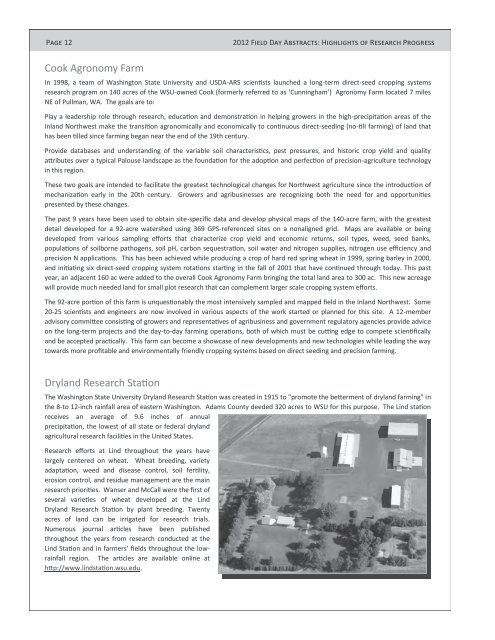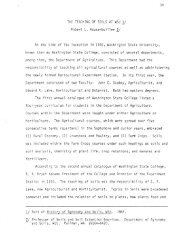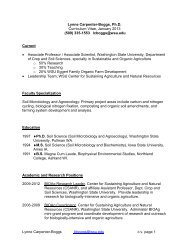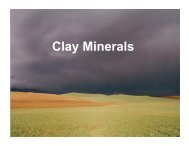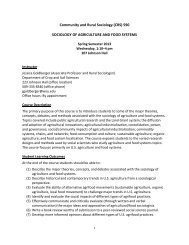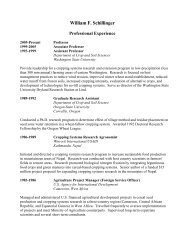2012 Dryland Field Day Abstracts - Dept. of Crop and Soil Sciences ...
2012 Dryland Field Day Abstracts - Dept. of Crop and Soil Sciences ...
2012 Dryland Field Day Abstracts - Dept. of Crop and Soil Sciences ...
You also want an ePaper? Increase the reach of your titles
YUMPU automatically turns print PDFs into web optimized ePapers that Google loves.
Page 12<br />
Cook Agronomy Farm<br />
<strong>2012</strong> <strong>Field</strong> <strong>Day</strong> <strong>Abstracts</strong>: Highlights <strong>of</strong> Research Progress<br />
In 1998, a team <strong>of</strong> Washington State University <strong>and</strong> USDA-ARS scientists launched a long-term direct-seed cropping systems<br />
research program on 140 acres <strong>of</strong> the WSU-owned Cook (formerly referred to as ‘Cunningham’) Agronomy Farm located 7 miles<br />
NE <strong>of</strong> Pullman, WA. The goals are to:<br />
Play a leadership role through research, education <strong>and</strong> demonstration in helping growers in the high-precipitation areas <strong>of</strong> the<br />
Inl<strong>and</strong> Northwest make the transition agronomically <strong>and</strong> economically to continuous direct-seeding (no-till farming) <strong>of</strong> l<strong>and</strong> that<br />
has been tilled since farming began near the end <strong>of</strong> the 19th century.<br />
Provide databases <strong>and</strong> underst<strong>and</strong>ing <strong>of</strong> the variable soil characteristics, pest pressures, <strong>and</strong> historic crop yield <strong>and</strong> quality<br />
attributes over a typical Palouse l<strong>and</strong>scape as the foundation for the adoption <strong>and</strong> perfection <strong>of</strong> precision-agriculture technology<br />
in this region.<br />
These two goals are intended to facilitate the greatest technological changes for Northwest agriculture since the introduction <strong>of</strong><br />
mechanization early in the 20th century. Growers <strong>and</strong> agribusinesses are recognizing both the need for <strong>and</strong> opportunities<br />
presented by these changes.<br />
The past 9 years have been used to obtain site-specific data <strong>and</strong> develop physical maps <strong>of</strong> the 140-acre farm, with the greatest<br />
detail developed for a 92-acre watershed using 369 GPS-referenced sites on a nonaligned grid. Maps are available or being<br />
developed from various sampling efforts that characterize crop yield <strong>and</strong> economic returns, soil types, weed, seed banks,<br />
populations <strong>of</strong> soilborne pathogens, soil pH, carbon sequestration, soil water <strong>and</strong> nitrogen supplies, nitrogen use efficiency <strong>and</strong><br />
precision N applications. This has been achieved while producing a crop <strong>of</strong> hard red spring wheat in 1999, spring barley in 2000,<br />
<strong>and</strong> initiating six direct-seed cropping system rotations starting in the fall <strong>of</strong> 2001 that have continued through today. This past<br />
year, an adjacent 160 ac were added to the overall Cook Agronomy Farm bringing the total l<strong>and</strong> area to 300 ac. This new acreage<br />
will provide much needed l<strong>and</strong> for small plot research that can complement larger scale cropping system efforts.<br />
The 92-acre portion <strong>of</strong> this farm is unquestionably the most intensively sampled <strong>and</strong> mapped field in the Inl<strong>and</strong> Northwest. Some<br />
20-25 scientists <strong>and</strong> engineers are now involved in various aspects <strong>of</strong> the work started or planned for this site. A 12-member<br />
advisory committee consisting <strong>of</strong> growers <strong>and</strong> representatives <strong>of</strong> agribusiness <strong>and</strong> government regulatory agencies provide advice<br />
on the long-term projects <strong>and</strong> the day-to-day farming operations, both <strong>of</strong> which must be cutting edge to compete scientifically<br />
<strong>and</strong> be accepted practically. This farm can become a showcase <strong>of</strong> new developments <strong>and</strong> new technologies while leading the way<br />
towards more pr<strong>of</strong>itable <strong>and</strong> environmentally friendly cropping systems based on direct seeding <strong>and</strong> precision farming.<br />
<strong>Dryl<strong>and</strong></strong> Research Station<br />
The Washington State University <strong>Dryl<strong>and</strong></strong> Research Station was created in 1915 to "promote the betterment <strong>of</strong> dryl<strong>and</strong> farming" in<br />
the 8-to 12-inch rainfall area <strong>of</strong> eastern Washington. Adams County deeded 320 acres to WSU for this purpose. The Lind station<br />
receives an average <strong>of</strong> 9.6 inches <strong>of</strong> annual<br />
precipitation, the lowest <strong>of</strong> all state or federal dryl<strong>and</strong><br />
agricultural research facilities in the United States.<br />
Research efforts at Lind throughout the years have<br />
largely centered on wheat. Wheat breeding, variety<br />
adaptation, weed <strong>and</strong> disease control, soil fertility,<br />
erosion control, <strong>and</strong> residue management are the main<br />
research priorities. Wanser <strong>and</strong> McCall were the first <strong>of</strong><br />
several varieties <strong>of</strong> wheat developed at the Lind<br />
<strong>Dryl<strong>and</strong></strong> Research Station by plant breeding. Twenty<br />
acres <strong>of</strong> l<strong>and</strong> can be irrigated for research trials.<br />
Numerous journal articles have been published<br />
throughout the years from research conducted at the<br />
Lind Station <strong>and</strong> in farmers’ fields throughout the lowrainfall<br />
region. The articles are available online at<br />
http://www.lindstation.wsu.edu.


